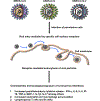Coronavirus Receptors as Immune Modulators
- PMID: 33380494
- PMCID: PMC7889699
- DOI: 10.4049/jimmunol.2001062
Coronavirus Receptors as Immune Modulators
Abstract
The Coronaviridae family includes the seven known human coronaviruses (CoV) that cause mild to moderate respiratory infections (HCoV-229E, HCoV-NL63, HCoV-OC43, HCoV-HKU1) as well as severe illness and death (MERS-CoV, SARS-CoV, SARS-CoV-2). Severe infections induce hyperinflammatory responses that are often intensified by host adaptive immune pathways to profoundly advance disease severity. Proinflammatory responses are triggered by CoV entry mediated by host cell surface receptors. Interestingly, five of the seven strains use three cell surface metallopeptidases (CD13, CD26, and ACE2) as receptors, whereas the others employ O-acetylated-sialic acid (a key feature of metallopeptidases) for entry. Why CoV evolved to use peptidases as their receptors is unknown, but the peptidase activities of the receptors are dispensable, suggesting the virus uses/benefits from other functions of these molecules. Indeed, these receptors participate in the immune modulatory pathways that contribute to the pathological hyperinflammatory response. This review will focus on the role of CoV receptors in modulating immune responses.
Copyright © 2021 by The American Association of Immunologists, Inc.
Figures


Similar articles
-
Innate Immune Signaling and Proteolytic Pathways in the Resolution or Exacerbation of SARS-CoV-2 in Covid-19: Key Therapeutic Targets?Front Immunol. 2020 May 28;11:1229. doi: 10.3389/fimmu.2020.01229. eCollection 2020. Front Immunol. 2020. PMID: 32574272 Free PMC article. Review.
-
Coronaviruses and SARS-COV-2.Turk J Med Sci. 2020 Apr 21;50(SI-1):549-556. doi: 10.3906/sag-2004-127. Turk J Med Sci. 2020. PMID: 32293832 Free PMC article. Review.
-
Overview of lethal human coronaviruses.Signal Transduct Target Ther. 2020 Jun 10;5(1):89. doi: 10.1038/s41392-020-0190-2. Signal Transduct Target Ther. 2020. PMID: 32533062 Free PMC article. Review.
-
HTCC as a Polymeric Inhibitor of SARS-CoV-2 and MERS-CoV.J Virol. 2021 Jan 28;95(4):e01622-20. doi: 10.1128/JVI.01622-20. Print 2021 Jan 28. J Virol. 2021. PMID: 33219167 Free PMC article.
-
Coronavirus HKU1 and other coronavirus infections in Hong Kong.J Clin Microbiol. 2006 Jun;44(6):2063-71. doi: 10.1128/JCM.02614-05. J Clin Microbiol. 2006. PMID: 16757599 Free PMC article.
Cited by
-
Small-molecule screening identifies Syk kinase inhibition and rutaecarpine as modulators of macrophage training and SARS-CoV-2 infection.Cell Rep. 2022 Oct 4;41(1):111441. doi: 10.1016/j.celrep.2022.111441. Epub 2022 Sep 15. Cell Rep. 2022. PMID: 36179680 Free PMC article.
-
Phage-Displayed Mimotopes of SARS-CoV-2 Spike Protein Targeted to Authentic and Alternative Cellular Receptors.Viruses. 2022 Feb 14;14(2):384. doi: 10.3390/v14020384. Viruses. 2022. PMID: 35215976 Free PMC article.
-
Mechanistic and Therapeutic Implications of Protein and Lipid Sialylation in Human Diseases.Int J Mol Sci. 2024 Nov 7;25(22):11962. doi: 10.3390/ijms252211962. Int J Mol Sci. 2024. PMID: 39596031 Free PMC article. Review.
-
Previous Humoral Immunity to the Endemic Seasonal Alphacoronaviruses NL63 and 229E Is Associated with Worse Clinical Outcome in COVID-19 and Suggests Original Antigenic Sin.Life (Basel). 2021 Apr 1;11(4):298. doi: 10.3390/life11040298. Life (Basel). 2021. PMID: 33915711 Free PMC article.
-
Research Progress in the Treatment of Complications and Sequelae of COVID-19.Front Med (Lausanne). 2021 Dec 2;8:757605. doi: 10.3389/fmed.2021.757605. eCollection 2021. Front Med (Lausanne). 2021. PMID: 34926504 Free PMC article. Review.
References
-
- Majumder MS, and Mandl KD. 2020. Early Transmissibility Assessment of a Novel Coronavirus in Wuhan, China. Ssrn: 3524675.
Publication types
MeSH terms
Substances
Grants and funding
LinkOut - more resources
Full Text Sources
Miscellaneous

